Wee bit of a shame there is no Fort Bill sleeper. That's one of the iconic journeys in @.
You are using an out of date browser. It may not display this or other websites correctly.
You should upgrade or use an alternative browser.
You should upgrade or use an alternative browser.
12:08 - Redux
- Thread starter Devvy
- Start date
1980-Sleepers-pt2
Devvy
Donor
Sleepers, part 2.
Sleeper services on British Rail now consist of three main services. The "Night Highlander" is an overnight train service operated by British Rail, Intercity sector. It runs daily, in each direction, between London (Euston) and Inverness, calling at several towns and cities north of the Central Belt. The rationalisation of sleeper services over the last 50 years has left Scotland with just two remaining overnight service, with the Night Highlander operating directly to/from London. The second from Scotland is an overnight service from Glasgow & Edinburgh to Paris, with additional stops in northern England, the "Night Parisian". The last sleeper service is the "Night Riviera", which operated from London to Penzance in Cornwall.
All 3 overnight services are, since 2015, formed of 12 British Rail Mark 4 coaches, made up of a variety of coaching stock, adding up to a total of 12 coaches. This creates a roughly 280 meter long train, which exceeds 300 metres when the locomotive is added to the mix. Onboard, regular use of Firewire[1] connections offer power up to 60W for personal devices, and also networking connections to the on-train network, allowing streaming of digital television channels, access to train system to see live location and punctuality information, as well as the ability to order your food choices for breakfast / dinner where appropriate.
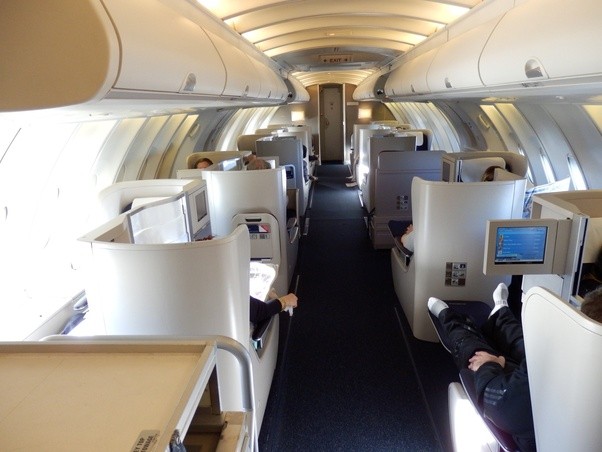
The upstairs 747 which provided inspiration for the new seated sleeper coaches, and a clear drive from British Rail for the more affluent market.
2 x Seated Sleeper Coach
The two "seated sleeper" coaches, are a cheaper option for travellers. Allowing passengers to store larger suitcases in the luggage area, the seats themselves form 2 seats on either side of the central aisle, and shows clear influence from airlines such as BA for their "Club World" seating. The seats recline back to form a flat bed at 183cm long, with pairs of seats facing each other at 45deg - although lacking the entertainment systems which are ubiquitous on airlines. The seat offers some inbuilt storage, and also offers three Firewire connections for power and networking to electronic devices such as smart phones, tablets and laptops.
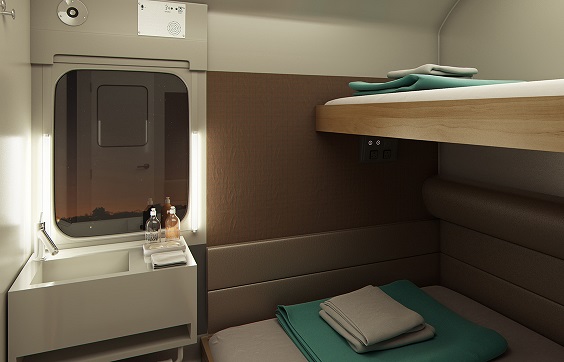
The new sleeping compartments.
7 x Sleeper Compartment Coach
The 7 "sleeper berth" coaches offer 10 compartments per coach, and offer a private room for sleeping. There are toilet/shower facilties at the front and rear of each coach for calls of nature, and personal grooming in the mornings. Although all coaching compartments can offer upper and lower berths to sleep in, in normal practice 3 coaches are used for single berths, 3 for twin (upper and lower) berths, with 1 coach (the middle one!) being switched as required for bookings. The rooms themselves include a small sink and mirror, 4 Firewire connections for electronics, and a small windows for seeing the morning landscape.
1 x Kitchen Buffet Coach
The kitchen coach includes the full dining kitchen for sleeper berth passengers, offering full hot meals on board - breakfasts on the northbound ones (complementary, from 05:50 onwards), and dinner on the southbound trips (not complementary). It also includes a smaller shop for all passengers, offering pre-packaged food and drink, as well as an array of newspapers and magazines. A small number of rows of seating (16 seats, 2 x 2 across around tables) around a table are available at the end of the coach, adjoining the next coach with a large amount of seating.
1 x Buffet Coach
The buffet coach offers a full length of 2 x 1 seating, all around tables, offering dining - dinner on the southbound route and breakfast on the northbound route, all cooked fresh by the kitchen for passengers in the sleeping compartments. The Night Highlander dinners are often Scottish themed, with haggis, neeps and tatties[2] a regular occurrence on the menu, whilst breakfast is invariably a full Scottish fry up. On the Riviera and Parisian services, meals are suitably themed as well, with full English fry ups for breakfast available, or Cornish / French cuisine for dinner.
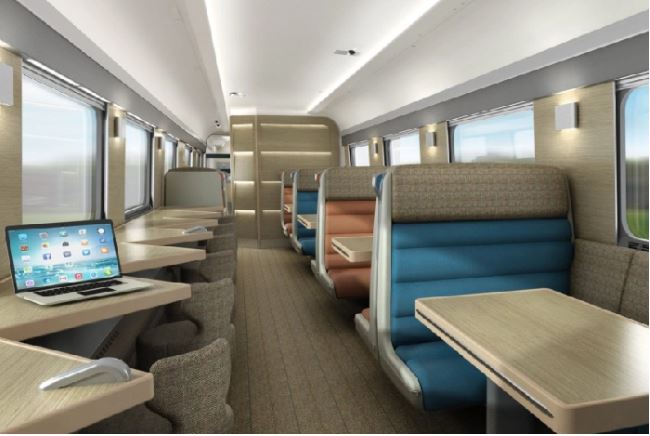
The new lounge carriage.
1 x Lounge Coach
The lounge coach offers comfortable seating and sofas, along with a well stocked bar at one end for evening entertainment. Many a night has been spent in the lounge area until the early hours, and on more than a handful of instances the bar has been drunk dry. After meals have been served (on the southbound trip), the buffet coach is also used as an extended lounge area.
The trains to Scotland are usually hauled by a new Class 92 dual-mode locomotive, derated to 75mph, for the distance between Paris / London and the Central Belt - the electrified sections. For onward travel to Aberdeen & Inverness, a Class 47 diesel locomotives take over, hauling the train onwards, deeper into Scotland where the electrification does not reach. A similar operation exists on the Night Riviera service, with an older Class 77 locomotive operating from London to Exeter on the largely electrified route via Bristol, with a Class 47 likewise taking over for operating the rest of the way through Cornwall.
Timetable[5]
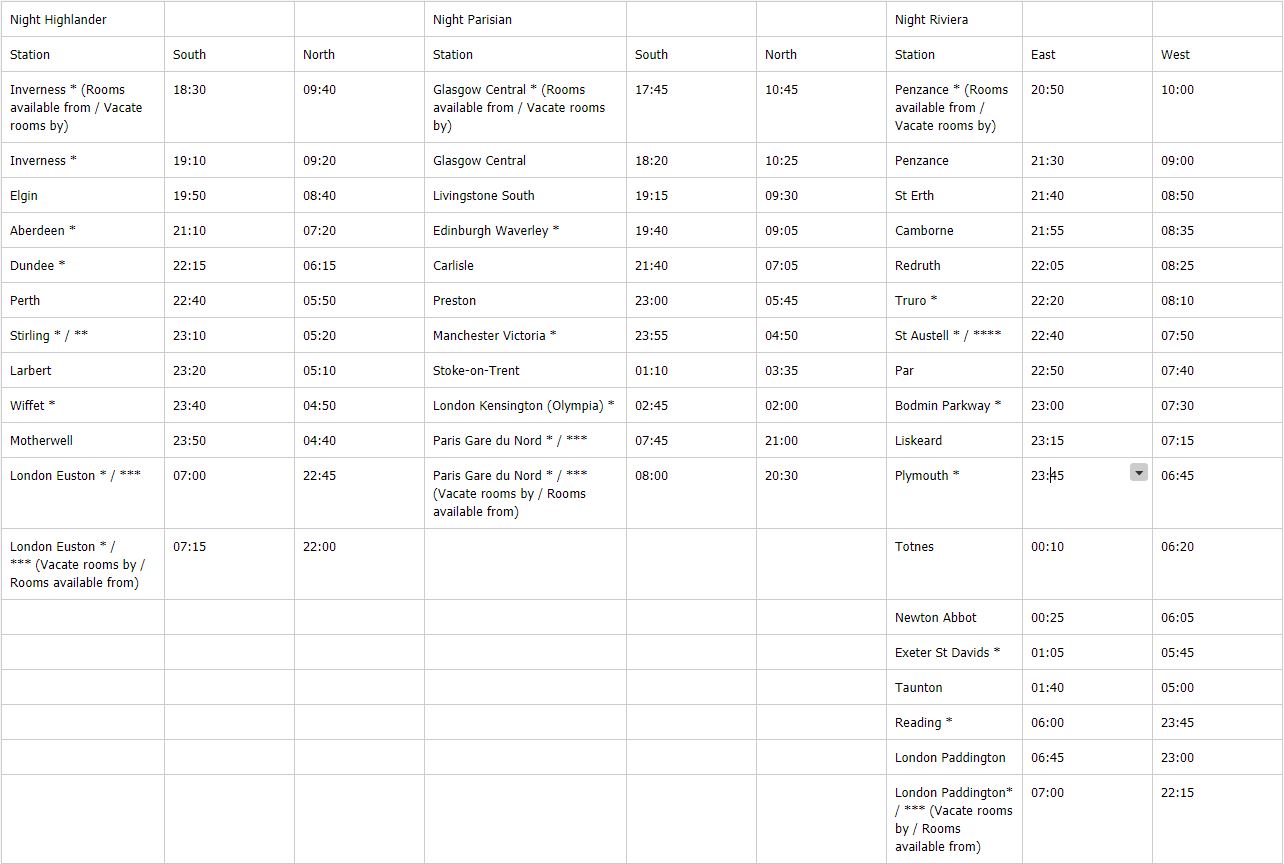
* Those marked have a Sleeper lounge in the station, providing snacks and drinks, and dependant on the time of day and pre-booking, can serve dinner or breakfast to arriving/departing passengers.
** Onward services are timed for quick connections to Fort William & Mallaig.[4]
*** Upon arrival at London Euston and Paris Gare du Nord, passengers may enjoy a complementary Full English breakfast in the Sleeper Lounge facilities if they so wish. Likewise, prior to departure, passengers may enjoy a full dinner prior to boarding in the Sleeper Lounge if desired (not complementary).
**** Onward services are timed for quick connections to Newquay.[6]
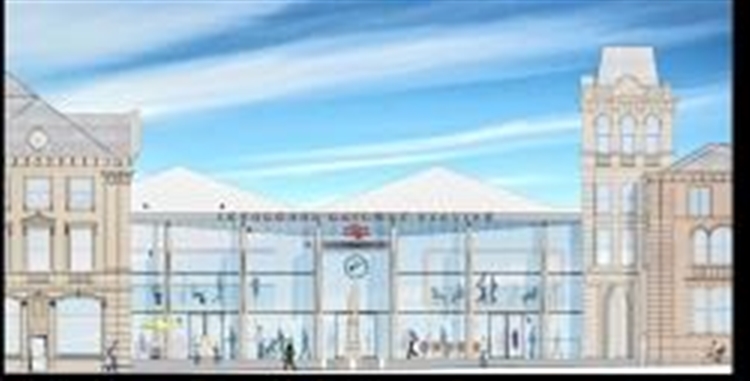
Artists depiction of a new Inverness station.
In future, due to the high levels of patronage now common on the sleeper services, the reverse of earlier reforms is now considered, with a growth of sleeper services planned for - especially due to the high price of motorway travel in current times. A split from a single 12 coach Night Highlander back to 2 shorter trains, one serving East Glasgow & Inverness, and the other serving Edinburgh & Aberdeen is one likely possibility. Other possibilities involve extending operations once again; the current station at Inverness is currently in the initial stages of planning for a rebuild. One revolutionary idea would involve a rebuild slightly north of the current station site and transforming it into a through station, which would allow the sleeper service to easily travel onwards from Inverness to either Kyle of Lochalsh for tourists, or Thurso for the Orkney Islands ferry. Another option would be the reinstatement of the direct Fort William sleeper service, although onwards travel to Mallaig would seem operationally difficult.
----------------------
Notes:
[1] Yes that says Firewire. The original iPhones used Firewire for charging and interfacing, so here we'll say Firewire rather than USB has become the de facto standard for some reasons:
[3] https://www.bbc.co.uk/news/magazine-27623739 - enjoy!
[4] Following the cancellation of the Fort William sleeper service in ATL in the 1990s (as BR tried to do in OTL), the Highland Council continued to campaign for a return but convenient connections at Stirling are as far as BR has gone on this. I'm thinking a circa 15 minute wait, of which the Sleeper lounge can be used to grab a hot drink and snack for the onward journey.
[5] Sorry for size, but obviously there's no way of nicely formatting a tablet on here so it had to be a picture. I think all those times are reasonable, and tried to balance having time for breakfast/dinners where possible on board.
[6] Yes, that's right, St Austell to Newquay. Will cover that another time.
And finally, as it's detailed, this post is liable to (platform) change at short notice if there are any issues.
Yep, quite agree. As noted here, BR tried to close off the FW sleeper route in the OTL 1990s for financial reasons, so here they've succeeded. Will be up that way in summer; after seeing the prices for the Jacobite, we'll watch it go past at Banavie, and then later board the normal Scotrail train for the scenery (and cheaper price...).
Sleeper services on British Rail now consist of three main services. The "Night Highlander" is an overnight train service operated by British Rail, Intercity sector. It runs daily, in each direction, between London (Euston) and Inverness, calling at several towns and cities north of the Central Belt. The rationalisation of sleeper services over the last 50 years has left Scotland with just two remaining overnight service, with the Night Highlander operating directly to/from London. The second from Scotland is an overnight service from Glasgow & Edinburgh to Paris, with additional stops in northern England, the "Night Parisian". The last sleeper service is the "Night Riviera", which operated from London to Penzance in Cornwall.
All 3 overnight services are, since 2015, formed of 12 British Rail Mark 4 coaches, made up of a variety of coaching stock, adding up to a total of 12 coaches. This creates a roughly 280 meter long train, which exceeds 300 metres when the locomotive is added to the mix. Onboard, regular use of Firewire[1] connections offer power up to 60W for personal devices, and also networking connections to the on-train network, allowing streaming of digital television channels, access to train system to see live location and punctuality information, as well as the ability to order your food choices for breakfast / dinner where appropriate.

The upstairs 747 which provided inspiration for the new seated sleeper coaches, and a clear drive from British Rail for the more affluent market.
2 x Seated Sleeper Coach
The two "seated sleeper" coaches, are a cheaper option for travellers. Allowing passengers to store larger suitcases in the luggage area, the seats themselves form 2 seats on either side of the central aisle, and shows clear influence from airlines such as BA for their "Club World" seating. The seats recline back to form a flat bed at 183cm long, with pairs of seats facing each other at 45deg - although lacking the entertainment systems which are ubiquitous on airlines. The seat offers some inbuilt storage, and also offers three Firewire connections for power and networking to electronic devices such as smart phones, tablets and laptops.

The new sleeping compartments.
7 x Sleeper Compartment Coach
The 7 "sleeper berth" coaches offer 10 compartments per coach, and offer a private room for sleeping. There are toilet/shower facilties at the front and rear of each coach for calls of nature, and personal grooming in the mornings. Although all coaching compartments can offer upper and lower berths to sleep in, in normal practice 3 coaches are used for single berths, 3 for twin (upper and lower) berths, with 1 coach (the middle one!) being switched as required for bookings. The rooms themselves include a small sink and mirror, 4 Firewire connections for electronics, and a small windows for seeing the morning landscape.
1 x Kitchen Buffet Coach
The kitchen coach includes the full dining kitchen for sleeper berth passengers, offering full hot meals on board - breakfasts on the northbound ones (complementary, from 05:50 onwards), and dinner on the southbound trips (not complementary). It also includes a smaller shop for all passengers, offering pre-packaged food and drink, as well as an array of newspapers and magazines. A small number of rows of seating (16 seats, 2 x 2 across around tables) around a table are available at the end of the coach, adjoining the next coach with a large amount of seating.
1 x Buffet Coach
The buffet coach offers a full length of 2 x 1 seating, all around tables, offering dining - dinner on the southbound route and breakfast on the northbound route, all cooked fresh by the kitchen for passengers in the sleeping compartments. The Night Highlander dinners are often Scottish themed, with haggis, neeps and tatties[2] a regular occurrence on the menu, whilst breakfast is invariably a full Scottish fry up. On the Riviera and Parisian services, meals are suitably themed as well, with full English fry ups for breakfast available, or Cornish / French cuisine for dinner.

The new lounge carriage.
1 x Lounge Coach
The lounge coach offers comfortable seating and sofas, along with a well stocked bar at one end for evening entertainment. Many a night has been spent in the lounge area until the early hours, and on more than a handful of instances the bar has been drunk dry. After meals have been served (on the southbound trip), the buffet coach is also used as an extended lounge area.
The trains to Scotland are usually hauled by a new Class 92 dual-mode locomotive, derated to 75mph, for the distance between Paris / London and the Central Belt - the electrified sections. For onward travel to Aberdeen & Inverness, a Class 47 diesel locomotives take over, hauling the train onwards, deeper into Scotland where the electrification does not reach. A similar operation exists on the Night Riviera service, with an older Class 77 locomotive operating from London to Exeter on the largely electrified route via Bristol, with a Class 47 likewise taking over for operating the rest of the way through Cornwall.
Timetable[5]

* Those marked have a Sleeper lounge in the station, providing snacks and drinks, and dependant on the time of day and pre-booking, can serve dinner or breakfast to arriving/departing passengers.
** Onward services are timed for quick connections to Fort William & Mallaig.[4]
*** Upon arrival at London Euston and Paris Gare du Nord, passengers may enjoy a complementary Full English breakfast in the Sleeper Lounge facilities if they so wish. Likewise, prior to departure, passengers may enjoy a full dinner prior to boarding in the Sleeper Lounge if desired (not complementary).
**** Onward services are timed for quick connections to Newquay.[6]

Artists depiction of a new Inverness station.
In future, due to the high levels of patronage now common on the sleeper services, the reverse of earlier reforms is now considered, with a growth of sleeper services planned for - especially due to the high price of motorway travel in current times. A split from a single 12 coach Night Highlander back to 2 shorter trains, one serving East Glasgow & Inverness, and the other serving Edinburgh & Aberdeen is one likely possibility. Other possibilities involve extending operations once again; the current station at Inverness is currently in the initial stages of planning for a rebuild. One revolutionary idea would involve a rebuild slightly north of the current station site and transforming it into a through station, which would allow the sleeper service to easily travel onwards from Inverness to either Kyle of Lochalsh for tourists, or Thurso for the Orkney Islands ferry. Another option would be the reinstatement of the direct Fort William sleeper service, although onwards travel to Mallaig would seem operationally difficult.
----------------------
Notes:
[1] Yes that says Firewire. The original iPhones used Firewire for charging and interfacing, so here we'll say Firewire rather than USB has become the de facto standard for some reasons:
- It can supply more power than USB (until USB-C-PD becomes standard in the months and years to come), and could do years ago, so it can charge devices far quicker and also power higher power devices such as laptops.
- Smart phones will therefore be smaller/lighter as batteries don't need to be quite so big - splash and dash is more common. Would you care if your iPhone only had a 12 hour battery life if you could charge it from 0% to 80% in 20 minutes for example?
- Firewire also allows network connections, so no need for wifi onboard if people are already plugging in to Firewire for power. Makes the provision of networking much simpler and easier to certify with wired connections as opposed to wireless connections.
[3] https://www.bbc.co.uk/news/magazine-27623739 - enjoy!
[4] Following the cancellation of the Fort William sleeper service in ATL in the 1990s (as BR tried to do in OTL), the Highland Council continued to campaign for a return but convenient connections at Stirling are as far as BR has gone on this. I'm thinking a circa 15 minute wait, of which the Sleeper lounge can be used to grab a hot drink and snack for the onward journey.
[5] Sorry for size, but obviously there's no way of nicely formatting a tablet on here so it had to be a picture. I think all those times are reasonable, and tried to balance having time for breakfast/dinners where possible on board.
[6] Yes, that's right, St Austell to Newquay. Will cover that another time.
And finally, as it's detailed, this post is liable to (platform) change at short notice if there are any issues.
Wee bit of a shame there is no Fort Bill sleeper. That's one of the iconic journeys in @.
Yep, quite agree. As noted here, BR tried to close off the FW sleeper route in the OTL 1990s for financial reasons, so here they've succeeded. Will be up that way in summer; after seeing the prices for the Jacobite, we'll watch it go past at Banavie, and then later board the normal Scotrail train for the scenery (and cheaper price...).
Devvy
Donor
Interesting- great entry.
I am surprised there is no Cornwall to Scotland service using a smaller sized train. Might be great for tourism?
I think the loadings will be far more seasonal for that route which isn't a great start for a train which requires special (sleeping) stock, and loading will be less than those to/from London or Paris. I can't see it being economical for BR to offer unfortunately. I did toy with timings for that kind of service too, but it's difficult to make the overnight portion work for such a route without stopping at major stations at an absurd time of the morning, and also there are a lot of fixed costs in operating this kind of train which will be a similar cost despite the smaller loadings; track access charges (even if internal) will be similar, staffing costs, the need to offer dining/restaurant car for breakfast/dinner, locomotive provision, etc - all are going to be similar costs despite lower loadings.
Huh, FireWire rules the World Wide Web waves in this universe, I’m assuming things like lightning cables and usb c would never be a thing in this universe if I’m correct? Also would phones, tablets and laptops evolve much differently ITTL?
Huh, FireWire rules the World Wide Web waves in this universe, I’m assuming things like lightning cables and usb c would never be a thing in this universe if I’m correct? Also would phones, tablets and laptops evolve much differently ITTL?
Firewire did have a ton of advantages in OTL, just similar to VHS vs Betamax, USB was cheaper and therefore 'cost effective' to use over the superior Firewire. In this universe its is different.
Last time I felt like death for a whole day after eating Haggis!
Just noticed that [3] does not link up to anything in the main text. Also in TTL I'd have to go to Perth (or maybe Waverley) to catch the Sleeper rather than Kirkcaldy, or Inverkeithing. So I'd be less likely to use it. No doubt the service would collapse without my ocasional use of it.
Just noticed that [3] does not link up to anything in the main text. Also in TTL I'd have to go to Perth (or maybe Waverley) to catch the Sleeper rather than Kirkcaldy, or Inverkeithing. So I'd be less likely to use it. No doubt the service would collapse without my ocasional use of it.
Last edited:
Haggis is ok I guess, if you like sausage
I like sausage (no laughing now!). Haggis is nothing like a sausage. The Night Highlander will need to serve square sausage to be properly Scottish.
I see you’ve got this routed via Stirling. Presumably that means that Callander-Crianlarich remains open?"The Night Highlander": London to Mallaig, via Carlisle, Motherwell[4], Stirling and Fort William.
I like sausage (no laughing now!). Haggis is nothing like a sausage. The Night Highlander will need to serve square sausage to be properly Scottish.
You clearly have never eaten a really cheap sausage
Wee question about the Glenfarg line seeing as it still survives. With it being built as a fast link between Edinburgh and Perth, wonder if Electrification will happen to it? Plus with the Lochty Private Railway closing in 1992 as per OTL, where will they go in Fife considering Kirkland is likely now busy with a passenger service still on the Fife Coast Line, unless the former sidings are free for them to use?
Devvy
Donor
Huh, FireWire rules the World Wide Web waves in this universe, I’m assuming things like lightning cables and usb c would never be a thing in this universe if I’m correct? Also would phones, tablets and laptops evolve much differently ITTL?
Firewire did have a ton of advantages in OTL, just similar to VHS vs Betamax, USB was cheaper and therefore 'cost effective' to use over the superior Firewire. In this universe its is different.
OTL, Firewire got tanked because of one of (to be fair) Steve Jobs' bad decisions - trying to milk the IP of Firewire (at $1 per port per device - significant if you are a mass manufacturer of devices with say 2 or 3 ports per computer!) before it had become a popular standard, which killed it off. Here, Intel has persuaded Apple to not be as heavy handed, and they've banded together with the other 5 IP holders for Firewire for joint licensing. Firewire offers networking, reliable video transfer (dedicated bandwidth) and power, so I can see it easily taking over from Ethernet and HDMI for home use (imagine a combined AV and Ethernet network which you plug your Virgin/Sky box in to, TV in to, internet router in to, and any local devices). You'd also see it as a slightly earlier option for in-flight connections, as it's the wifi part which is/was difficult to certify to use onboard as it's wireless and could theoretically affect plane ops - not a risk with wired comms on Firewire. It would also be an easy sell for buildings management; CCTV cameras have a video interface to transmit on as well as take power from, as well as other peripherals.
Laptops, phones and tablets we'll say evolve roughly similarly, although the wider-spread "hotspots" of Firewire connections, say on the tables in you local coffee shop of choice, on the trains, in airport lounges mean batteries can be a tad smaller as your opportunities for topping up the charge are far more frequent. Also although 60W might be the lower end of the power requirements, it will still charge a phone/tablet far quicker (USB2 does 7.5W usually, so here Firewire can potentially charge a phone 6-8x quicker), and will power most modern day laptops perfectly although the battery might charge slower if the computer is under heavy workload. This means that you'd see a lot of laptops adopting Firewire not only for networking, but also for power input, meaning no PSU to lug around - just carry your Firewire cable and plug in wherever! I'm sure the ATL 2020 Firewire will offer maybe 100W power and some stupid level of bandwidth for the bus considering they had 3gb/s by 2010 (bear in mind it's a shared bus, which is carrying IP traffic, video streams between devices, and maybe file copies between devices?).
If cards were played correctly, a second firewire controller could also do "local resources" such as keyboard, mouse, local display that you don't want networked. Suffice to say, as a PC engineer who works for a semi-major OEM, I think Firewire was a superb technology killed off by corporate greed and stupidity compared to the simple and freely licensed USB which proliferated.
I'll stop there before I sidetrack (again, no pun intended...) a rail TL any further!
Just noticed that [3] does not link up to anything in the main text. Also in TTL I'd have to go to Perth (or maybe Waverley) to catch the Sleeper rather than Kirkcaldy, or Inverkeithing. So I'd be less likely to use it. No doubt the service would collapse without my ocasional use of it.
Yup! This is BR cost cutting at it's finest, but also there are other reasons (faster services) we'll get to why the sleeper doesn't go to Edinburgh which reduce the economics of such a service, so you'll need to get to Perth. Or possibly Stirling if Stirling-Alloa-Dunfermline (Upper) remains open.
I see you’ve got this routed via Stirling. Presumably that means that Callander-Crianlarich remains open?
Yeah - this was mentioned in one of the earlier chapters ( https://www.alternatehistory.com/forum/threads/12-08-redux.454571/page-2#post-17976238 ). Basically Helensburgh-Crianlarich was shut to allow the longer distance routing of West Highland services away from the soon to be metro style services across Glasgow. There was some additional discussion after that post too about it.
Also enjoyed the haggis/sausage banter
Wee question about the Glenfarg line seeing as it still survives. With it being built as a fast link between Edinburgh and Perth, wonder if Electrification will happen to it? Plus with the Lochty Private Railway closing in 1992 as per OTL, where will they go in Fife considering Kirkland is likely now busy with a passenger service still on the Fife Coast Line, unless the former sidings are free for them to use?
Yes. I want the Glenfarg line to survive, although this has knock on consequences; Devon Valley, Fife & Kinross, Ladybank-Bridge of Earn are all probably gone here. Ladybank is just a stop en route to Leuchars and Dundee. ( https://en.wikipedia.org/wiki/Railways_of_Kinross#/media/File:Kinross_lines_1890.png )
Last edited:
Yes. I want the Glenfarg line to survive, although this has knock on consequences; Devon Valley, Fife & Kinross, Ladybank-Bridge of Earn are all probably gone here. Ladybank is just a stop en route to Leuchars and Dundee. ( https://en.wikipedia.org/wiki/Railways_of_Kinross#/media/File:Kinross_lines_1890.png )
Devon Valley was bound to go, however there was an interesting what if moment for the SRPS in which they almost got the Devon Valley Line between Alloa and Dollar in 1973 in which the council chased them out and eventually saw them set up in Bo'ness. Maybe they have more success here, plus if steam lasted longer here and potitional the loss of several Scottish built steam locomotives is butterflied away and that the Scottish heritage railway scene here is more developed perhaps than OTL? I do think an update on the heritage railways here might be worth an update to see what's happened here maybe?
Devvy
Donor
Devon Valley was bound to go, however there was an interesting what if moment for the SRPS in which they almost got the Devon Valley Line between Alloa and Dollar in 1973 in which the council chased them out and eventually saw them set up in Bo'ness. Maybe they have more success here, plus if steam lasted longer here and potitional the loss of several Scottish built steam locomotives is butterflied away and that the Scottish heritage railway scene here is more developed perhaps than OTL? I do think an update on the heritage railways here might be worth an update to see what's happened here maybe?
Yes, I definitely do have heritage chapters planned, but bear in mind we are still at roughly late 1970s / early 1980s currently - despite the occasional "flash forward". At this point, the heritage movement is in it's infancy - the 1980s is when most heritage routes began to make their mark up and down the country, but we will get there; I think the slower phase out of steam means that several of the more interesting locomotives will survive to be bought out by enthusiasts.
1982-Chunnel
Devvy
Donor
1982 - Excerpts from "A Brief History of the Channel Tunnel", by Philip Fagg
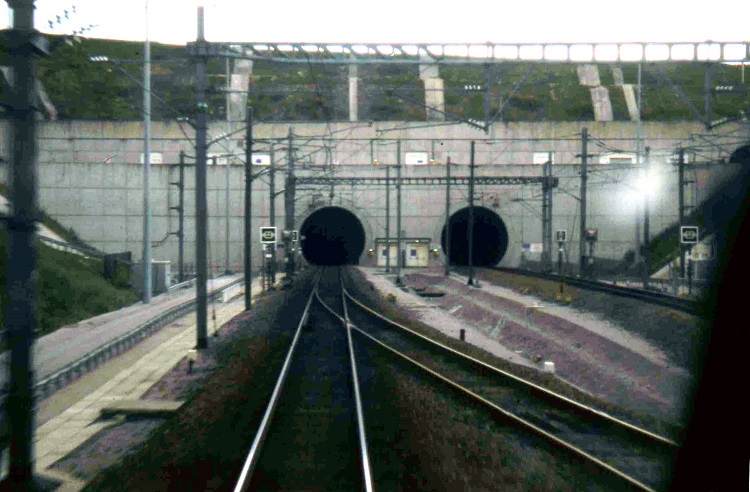
A cabin view of the tunnel portals.
The Channel Tunnel opened to large pomp and circumstance in 1982 - a delay of 2 years based upon the original estimates. The link ended the centuries of Britain's "Glorious Isolation" as an island, permanently and physically tying Britain to Europe. Following decades of speculation, conceptual plans and pipe-dreams[1] (and scares during wartime!), the Channel Tunnel began construction in the 1960s, and survived deep political discussion in the early 1970s. The link allows trains to directly traverse the English Channel, and connect between the British and French main line rail networks. Specially built trains to convey cars and other smaller vehicles between the UK and France under the sea, whilst international freight trains, compatible with all the Rail Treaty signatories networks will haul intermodel containers between the countries. New express trains will eventually link the major cities together, although failure to agree on immigration issues has meant that on-board passenger checks will not be permitted and must be done prior to entry in the other country, forcing an elaborate cross-border solution when new high speed lines eventually permit services to operate. The 'Chunnel' has already seen political consequences of this, with European nations (but not the United Kingdom) beginning to discuss a free movement pact, dropping the need for internal passport checks.[2]
The "tunnel" actually consists of 3 separate tunnels. 2 main line tunnels, both allowing 4.5 meter high rolling stock, sandwich a smaller service & emergency tunnel. The large tunnels allow the giant rolling stock required to convey vehicles - both a 3 trains per hour car shuttle, ferrying vehicles from England to France, as well as the enormous 1 train per hour lorry shuttle. Both vehicle shuttles are specially designed for their purpose; large wagons (and low slung ones in the case of the lorry shuttle) designed to carry as many vehicles as possible across the Chunnel in a single trip. These services were the defining point in the length discussion over which electrification standard to use in the tunnel, considering both France and Britain had largely standardised on 1,500v DC for their standard rail networks. The final decision of embracing 25kV AC was a result of the need for large and very heavy trains, to be hauled by extremely powerful locomotives to make it up the gradients from the tunnel low point under the sea, and the 25kV AC power system was the one which could allow the locomotives to generate enough power for the haul. The Shuttle transfer yard on the French side was built just outside the tunnel portal in Calais, whilst difficulties in squeezing the British yard in to the tight confines of Folkestone [3] led to an extended journey to the yard at Ashford, adjacent to the M20 - an extra 11 miles of large loading gauge tracks, adding approximately 10 minutes to the end-to-end journey time (but saving the corresponding amount in onwards journey time). In hindsight, this turned out to be a stroke of good luck, as police have regularly used the M20 towards Dover to park lorries, causing significant congestion, when the ferries are unable to operate due to weather conditions (or other issues such as strikes); the Channel Tunnel terminus at Ashford avoids any of these queues and parking areas[4].
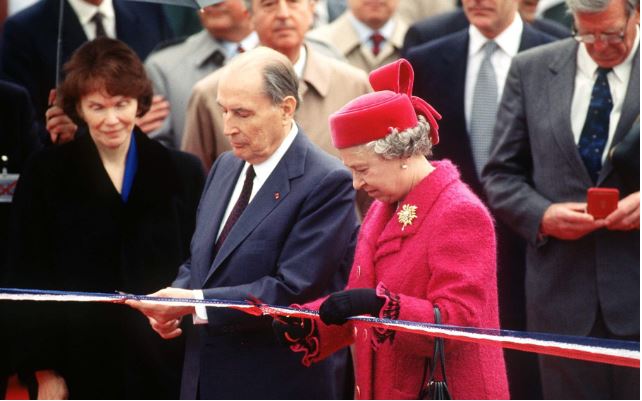
Her Majesty the Queen and the President of France open the Channel Tunnel together.[6]
Other services through the tunnel will include the hauling of classic freight trains - initially both British Rail and SNCF have agreed for an intermodel container train service between the two countries. Specially qualified train drivers, with the new WEG Train driving permit, will drive Freightliner trains from British depots to France - specifically to a new freight depot near the Autoroute network outside Calais. From there, SNCF drivers will convey trains onwards to their French destination - or soon, Dutch (NMBS) or Belgian (SNCB) trains to their respective networks. Whilst initially SNCF had ideas of conveying the freight trains to a yard in Britain, the restrictive loading gauge precluded most of their rolling stock from use in Britain. All 4 rail companies continued to also study the potential for wagonload freight, with a roughly outlined concept of a large international marshalling yard between Lille and Calais.
The locomotives themselves eventually went out for tender, with British Rail and SNCF unable to agree a joint process, with tenders from 3 organisations for the supply of 40 locomotives, with a variety of British and French inspired designs. With a locomotive provided front and back for duplication and disaster recovery - with requirements for a locomotive to be able to haul the train out of the tunnel by itself with a disabled bogie, the trains needed significant power, delivered by the overhead electricity. The winning design, a joint effort by ABB and Brush Traction, was for a Co-Co (2 bogies of 3 powered axles each [5]) with a total power of 5 MW - one of the most powerful locomotives at the time. Each locomotive was equipped with dual pantographs for redundancy, both feeding a common power system and with separate bogie mounted motors for each axle. The risk of tunnel-vision in the Channel Tunnel led to the windows being only front facing small windows, and also required the use of new in-cab signalling, largely using the French method due to the new build tracks, to reduce the risk of any incident within the tight confines at the tunnel - and also allow the short 4 minute signalling headways required for the service frequency desired.
--------------
[1] No pun intended....
[2] An earlier push for Schengen resulting from the earlier high speed rail efforts; probably Schengen Agreement signed circa 1982/3, with enactment in 1990ish, for elimination of passport checks & common visa policy. Still can't see the UK wanting in to this though, so will remain as per OTL with the CTA on one side, and Schengen on the other side of the Chunnel!
[3] Ashford was actually an early idea for the Chunnel yard, and here has maintained. In part, because of the Co-Co locomotive design (instead of Bo-Bo-Bo - ie. 2 x 3 axles bogies, instead of 3 x 2 axle bogies), means the curve radius has to be a bit larger to allow the locomotive to round the bend. Folkestone Chunnel terminal (OTL) has an incredibly tight radius, allowed by the OTL Euroshuttle loco design.
[4] Operation Stack...
[5] As opposed to the OTL Bo-Bo-Bo design (3 axles of 2 bogies each - which is technically harder as the middle bogie needs to shift to the left and right to accommodate curves). I've done this as we are earlier than OTL, and therefore still a little more traditional in terms of locomotive design, and also as the decade earlier project won't be quite the same in terms of such demands over locomotive failsafes. It also leads on to [3] as a consequence.
[6] Yes, the 1982 opening date means I can just use an OTL picture featuring the correct French President
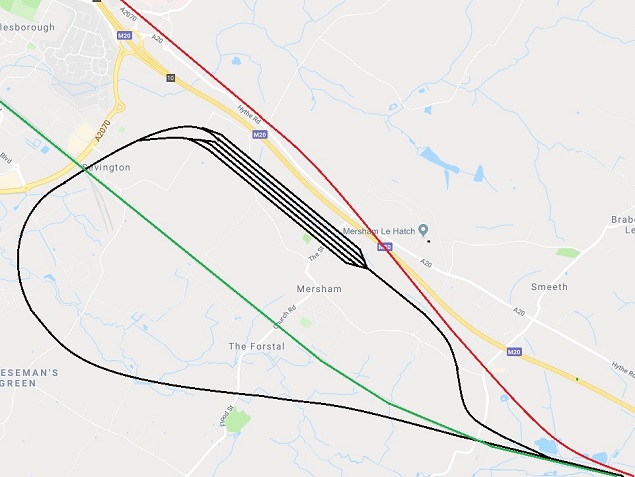
What I'd imagine the Ashford Eurotunnel terminal looking like. I'd imagine 2-3 trains per hour of car shuttles, and probably 1 train per hour of freight shuttle to start with. Red is the high speed line, bypassing Ashfield, Green is the standard BR route, and Black is the Eurostunnel route. Main motorway access via an enlargened, and better slipstreamed Junction 10.

A cabin view of the tunnel portals.
The Channel Tunnel opened to large pomp and circumstance in 1982 - a delay of 2 years based upon the original estimates. The link ended the centuries of Britain's "Glorious Isolation" as an island, permanently and physically tying Britain to Europe. Following decades of speculation, conceptual plans and pipe-dreams[1] (and scares during wartime!), the Channel Tunnel began construction in the 1960s, and survived deep political discussion in the early 1970s. The link allows trains to directly traverse the English Channel, and connect between the British and French main line rail networks. Specially built trains to convey cars and other smaller vehicles between the UK and France under the sea, whilst international freight trains, compatible with all the Rail Treaty signatories networks will haul intermodel containers between the countries. New express trains will eventually link the major cities together, although failure to agree on immigration issues has meant that on-board passenger checks will not be permitted and must be done prior to entry in the other country, forcing an elaborate cross-border solution when new high speed lines eventually permit services to operate. The 'Chunnel' has already seen political consequences of this, with European nations (but not the United Kingdom) beginning to discuss a free movement pact, dropping the need for internal passport checks.[2]
The "tunnel" actually consists of 3 separate tunnels. 2 main line tunnels, both allowing 4.5 meter high rolling stock, sandwich a smaller service & emergency tunnel. The large tunnels allow the giant rolling stock required to convey vehicles - both a 3 trains per hour car shuttle, ferrying vehicles from England to France, as well as the enormous 1 train per hour lorry shuttle. Both vehicle shuttles are specially designed for their purpose; large wagons (and low slung ones in the case of the lorry shuttle) designed to carry as many vehicles as possible across the Chunnel in a single trip. These services were the defining point in the length discussion over which electrification standard to use in the tunnel, considering both France and Britain had largely standardised on 1,500v DC for their standard rail networks. The final decision of embracing 25kV AC was a result of the need for large and very heavy trains, to be hauled by extremely powerful locomotives to make it up the gradients from the tunnel low point under the sea, and the 25kV AC power system was the one which could allow the locomotives to generate enough power for the haul. The Shuttle transfer yard on the French side was built just outside the tunnel portal in Calais, whilst difficulties in squeezing the British yard in to the tight confines of Folkestone [3] led to an extended journey to the yard at Ashford, adjacent to the M20 - an extra 11 miles of large loading gauge tracks, adding approximately 10 minutes to the end-to-end journey time (but saving the corresponding amount in onwards journey time). In hindsight, this turned out to be a stroke of good luck, as police have regularly used the M20 towards Dover to park lorries, causing significant congestion, when the ferries are unable to operate due to weather conditions (or other issues such as strikes); the Channel Tunnel terminus at Ashford avoids any of these queues and parking areas[4].

Her Majesty the Queen and the President of France open the Channel Tunnel together.[6]
Other services through the tunnel will include the hauling of classic freight trains - initially both British Rail and SNCF have agreed for an intermodel container train service between the two countries. Specially qualified train drivers, with the new WEG Train driving permit, will drive Freightliner trains from British depots to France - specifically to a new freight depot near the Autoroute network outside Calais. From there, SNCF drivers will convey trains onwards to their French destination - or soon, Dutch (NMBS) or Belgian (SNCB) trains to their respective networks. Whilst initially SNCF had ideas of conveying the freight trains to a yard in Britain, the restrictive loading gauge precluded most of their rolling stock from use in Britain. All 4 rail companies continued to also study the potential for wagonload freight, with a roughly outlined concept of a large international marshalling yard between Lille and Calais.
The locomotives themselves eventually went out for tender, with British Rail and SNCF unable to agree a joint process, with tenders from 3 organisations for the supply of 40 locomotives, with a variety of British and French inspired designs. With a locomotive provided front and back for duplication and disaster recovery - with requirements for a locomotive to be able to haul the train out of the tunnel by itself with a disabled bogie, the trains needed significant power, delivered by the overhead electricity. The winning design, a joint effort by ABB and Brush Traction, was for a Co-Co (2 bogies of 3 powered axles each [5]) with a total power of 5 MW - one of the most powerful locomotives at the time. Each locomotive was equipped with dual pantographs for redundancy, both feeding a common power system and with separate bogie mounted motors for each axle. The risk of tunnel-vision in the Channel Tunnel led to the windows being only front facing small windows, and also required the use of new in-cab signalling, largely using the French method due to the new build tracks, to reduce the risk of any incident within the tight confines at the tunnel - and also allow the short 4 minute signalling headways required for the service frequency desired.
--------------
[1] No pun intended....
[2] An earlier push for Schengen resulting from the earlier high speed rail efforts; probably Schengen Agreement signed circa 1982/3, with enactment in 1990ish, for elimination of passport checks & common visa policy. Still can't see the UK wanting in to this though, so will remain as per OTL with the CTA on one side, and Schengen on the other side of the Chunnel!
[3] Ashford was actually an early idea for the Chunnel yard, and here has maintained. In part, because of the Co-Co locomotive design (instead of Bo-Bo-Bo - ie. 2 x 3 axles bogies, instead of 3 x 2 axle bogies), means the curve radius has to be a bit larger to allow the locomotive to round the bend. Folkestone Chunnel terminal (OTL) has an incredibly tight radius, allowed by the OTL Euroshuttle loco design.
[4] Operation Stack...
[5] As opposed to the OTL Bo-Bo-Bo design (3 axles of 2 bogies each - which is technically harder as the middle bogie needs to shift to the left and right to accommodate curves). I've done this as we are earlier than OTL, and therefore still a little more traditional in terms of locomotive design, and also as the decade earlier project won't be quite the same in terms of such demands over locomotive failsafes. It also leads on to [3] as a consequence.
[6] Yes, the 1982 opening date means I can just use an OTL picture featuring the correct French President

What I'd imagine the Ashford Eurotunnel terminal looking like. I'd imagine 2-3 trains per hour of car shuttles, and probably 1 train per hour of freight shuttle to start with. Red is the high speed line, bypassing Ashfield, Green is the standard BR route, and Black is the Eurostunnel route. Main motorway access via an enlargened, and better slipstreamed Junction 10.
Share: